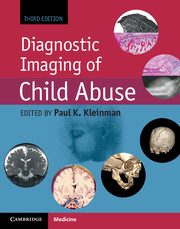Book contents
- Frontmatter
- Dedication
- Contents
- List of Contributors
- Editor’s note on the Foreword to the third edition
- Foreword to the third edition
- Foreword to the second edition
- Foreword to the first edition
- Preface
- Acknowledgments
- List of acronyms
- Introduction
- Section I Skeletal trauma
- Section II Abusive head and spinal trauma
- Chapter 16 Abusive head trauma: clinical, biomechanical, and imaging considerations
- Chapter 17 Abusive head trauma: scalp, subscalp, and cranium
- Chapter 18 Abusive head trauma: extra-axial hemorrhage and nonhemic collections
- Chapter 19 Abusive head trauma: parenchymal injury
- Chapter 20 Abusive head trauma: intracranial imaging strategies
- Chapter 21 Abusive craniocervical junction and spinal trauma
- Section III Visceral trauma and miscellaneous abuse and neglect
- Section IV Diagnostic imaging of abuse in societal context
- Section V Technical considerations and dosimetry
- Index
- References
Chapter 21 - Abusive craniocervical junction and spinal trauma
from Section II - Abusive head and spinal trauma
Published online by Cambridge University Press: 05 September 2015
- Frontmatter
- Dedication
- Contents
- List of Contributors
- Editor’s note on the Foreword to the third edition
- Foreword to the third edition
- Foreword to the second edition
- Foreword to the first edition
- Preface
- Acknowledgments
- List of acronyms
- Introduction
- Section I Skeletal trauma
- Section II Abusive head and spinal trauma
- Chapter 16 Abusive head trauma: clinical, biomechanical, and imaging considerations
- Chapter 17 Abusive head trauma: scalp, subscalp, and cranium
- Chapter 18 Abusive head trauma: extra-axial hemorrhage and nonhemic collections
- Chapter 19 Abusive head trauma: parenchymal injury
- Chapter 20 Abusive head trauma: intracranial imaging strategies
- Chapter 21 Abusive craniocervical junction and spinal trauma
- Section III Visceral trauma and miscellaneous abuse and neglect
- Section IV Diagnostic imaging of abuse in societal context
- Section V Technical considerations and dosimetry
- Index
- References
Summary
Introduction
Spine injuries are uncommon but nonetheless important manifestations of child abuse. In infants and young children, spinal fractures have a strong association with abuse and their identification should raise the possibility of inflicted injury if an adequate history is not provided. The diagnosis of abusive spinal injury can be difficult for a number of reasons: (1) clinical assessment may be challenging based on the history provided by the caretaker – it may or may not be factual; (2) a history is usually not available from the victim since most abused children are preverbal, and those who are not may be neurologically compromised from associated head injury; (3) attention may be diverted elsewhere to more immediate and clinically apparent injuries; (4) physical examination may not reveal signs of spinal injury or neurologic deficits; and (5) initial imaging is frequently normal, particularly when cervical injuries are present. Thus, “silent” injuries can be missed unless appropriate imaging is performed. In addition, a clinically occult spinal fracture may be identified on cross-sectional imaging performed for other reasons.
Mild spinal injuries may go undiagnosed without adverse clinical result. Severe injuries can have catastrophic neurologic consequences (Fig. 21.1), and undiagnosed spinal injuries with ongoing instability can lead to persistent pain, repetitive cord injury, and spinal deformity.
- Type
- Chapter
- Information
- Diagnostic Imaging of Child Abuse , pp. 494 - 560Publisher: Cambridge University PressPrint publication year: 2015
References
- 4
- Cited by



